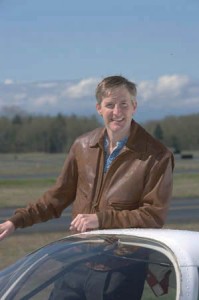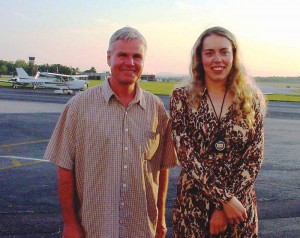By Henry M. Holden,
The Aircraft Owners and Pilots Association is concerned that the overall pilot population has declined 25 percent since its peak in 1980, while the U.S. population has grown 29 percent. A key issue is that the decrease in the number of student pilots coming into the system is down 61 percent since its peak in 1961. AOPA also claims 60 to 65 percent of the students never complete training and get a certificate.

AOPA spokesperson Erik Lindbergh wants to help reverse the decline of pilots in general aviation by speaking on behalf of the organization. Lindbergh himself was a mentored student and understands and appreciates the role of a mentor.
“General aviation is in dire straits,” said Jeff Myers, executive vice president of communications for AOPA. “New student pilot starts are in a severe downward spiral. If we all don’t do something about this, the future of GA is in grave danger.”
GA includes all flying except the scheduled airlines and the military. Nearly two-thirds of all U.S. pilots and three-quarters of the GA pilots are AOPA members.
To combat this downward spiral, AOPA President Phil Boyer and Erik Lindbergh, AOPA Project Pilot spokesman and grandson of the world’s most famous pilot, Charles Lindbergh, launched the AOPA Project Pilot program at the AOPA’s 16th Annual Open House and Fly-In on June 3. This program is designed to increase the number of general aviation pilots nationwide by teaming experienced AOPA member pilots as mentors with student pilots.
“This is an opportunity for AOPA members to find and support the next generation of GA pilots,” said Boyer.
Erik Lindbergh, a pilot, flew transatlantic to commemorate the 75th anniversary of his grandfather’s flight. He’s dedicated to creating a ground swell of support for general aviation, just as his grandfather did almost eight decades ago. AOPA members in the United States who would like to join Lindbergh and Boyer in this important mission are encouraged to join the AOPA Project Pilot program as mentors.
Lindbergh is a classic example of the benefits of a mentor. He didn’t get into aviation because of his famous grandparents or his parents, who were also pilots. He had no desire to be a pilot until a good friend encouraged him to take an introductory flight. The flying bug bit Lindbergh hard.
“If he hadn’t been mentored, he may never have started flight training or completed his training,” Myers said.
Myers said Project Pilot is a new and greatly improved version of a 1994 program.
“Based on our research from that program, we expect about 8,000 to 10,000 new student pilot starts a year,” he said. “We also discovered that student pilots who are mentored are three times more likely to successfully complete their training.”
Myers believes there are several reasons for the decline in new student pilots. Student pilots face a number of obstacles, including incompatibility with the CFI; mic fright, where the student is afraid, or embarrassed to talk to the ATC; physical illness; and fear of heights.” Other obstacles include not enough time or money.

Buster Spriggs and Lena Bulatova demonstrated that long-distance mentoring can be successful. Bulatova plans on one day earning a commercial license. Spriggs found the mentoring rewarding and will do it again.
“You don’t have to rush through your flight training,” said Myers. “Pardon the pun, but it shouldn’t be a crash course. It’s OK to take some time off, or pay a bill one month rather than take a flight lesson. “Remember that every hour in your logbook is there to stay.”
Project Pilot addresses many obstacles students face.
“Project Pilot addresses the mentor/student/CFI relationships,” said Myers. “We don’t recommend the student’s mentor also be the CFI, although that arrangement may work. We see the mentor as an objective third party, one who can facilitate the CFI/student relationship from an arm’s length. Project Pilot also addresses a situation where the student and CFI don’t mix well, and where there may be an initial mismatch of a student and a mentor.”
Project Pilot gives experienced pilots a way to pass along their skill and enthusiasm to student pilots. AOPA members identify friends, family members or coworkers who have the time, money and desire to learn to fly, and then mentor them through the flight training process to a private pilot certificate.
“Our goal is to increase the number of general aviation pilots,” said Boyer. “There’s strength in numbers, and keeping general aviation vibrant benefits the entire industry.”
There’s no cost for this program to the mentors or the students. Each receives a welcome kit after joining the program. The mentor kit includes a Project Pilot mouse pad, decals, a brochure and greetings from Lindbergh and Boyer. The student kit includes a greeting from Lindbergh, a personal letter from Boyer, a special magazine to help the student get started, project decals and an exciting and informative DVD.
Participants must be U.S. citizens, but Project Pilot doesn’t limit the mentor and the student to the same airport. Modern technology makes this work for many mentor-student teams, and there have been successful distant partnerships in the past. With encouraging phone calls and emails, it’s possible for a student to get all the help he or she needs.

According to AOPA, mentored students are three times more likely to finish their flight training and earn their license. AOPA has a Project Pilot kit for both mentor and student, to facilitate the relationship.
There’s no better example of the utility of GA than flying to meet a student on a cross-country flight, or a friend who’s a newly certified pilot. Buster Spriggs mentored Lena Bulatova, who was born in Russia, and who now lives in Knoxville, Tenn.
“Lena passed her check ride on Feb. 18, 2005. She plans to continue flight training and become a commercial pilot,” said Spriggs. “We met online through the AOPA website. We eventually met each other in person by accident at Volunteer Aviation, in Knoxville. I had stopped there briefly on a cross-country flight. I saw a young girl preflighting a Piper Warrior, and asked her if she knew a student pilot named Lena. She smiled, and said, ‘I’m Lena, and you must be Buster.’ The mentoring experience was rewarding for me and I plan to do it again.”
The procedure for nominating a likely candidate to be a student pilot or sign up as a mentor is to simply use the online nomination form, or call AOPA on the toll-free pilot assistance line, 800-USA-AOPA (800-872-2672).
The program can be found online at www.aopaprojectpilot.org. The website is a rich source of information, with videos covering all the aspects of the program to help get students started and help them throughout their flight training. The website also makes it easy for mentors and students to connect and keep in touch, and it also allows the students to track their flight training progress online.
“We’re targeting all 408,000 AOPA member pilots who can be mentors and part of Project Pilot,” said Myers. “This isn’t somebody else’s problem; it concerns all of us. AOPA members have always risen to the occasion and addressed serious past issues in aviation. We don’t expect this to be an exception.”











